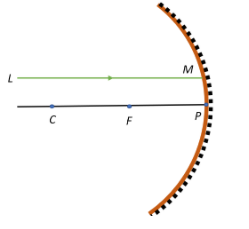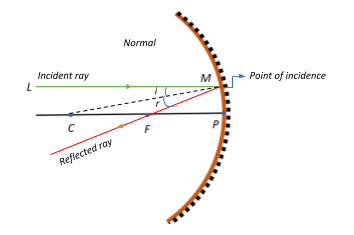
A ray of light LM is incident on a mirror as shown in the figure. The angle of incidence for the ray is the angle between it and the line joining the other points in the figure. Name these two points.


Answer
435.6k+ views
Hint: We know that the angle of incidence is the angle between the incident ray and the normal. In this case, think of where the normal would lie. Also, notice that the incident ray seems to be coming from infinity. In such a case, we know that the reflected ray would arrive at the focus. Using the two postulates, determine the points which the normal to the mirror surface would pass through.
Complete Step-by-Step Solution:
We have a ray of light LM incident on the surface of a concave mirror. Let us first understand what the angle of incidence entails.
The angle of incidence is optically defined as the angle between the ray incident on the surface and the line perpendicular to the surface at the point of incidence, which is often called the normal.

In the given diagram we see that the incident ray LM gets reflected from the surface of the mirror in such a way that the reflected ray passes through the focal point F of the mirror.
The perpendicular bisector of the angle between the incident ray and the reflected ray is nothing but the normal drawn to the surface of the mirror at the point of incidence of the ray. Thus, the angle of incidence becomes the angle between the incident ray and the normal to the point of incidence at the mirror surface.
Now, this normal which bisects the incident and reflected rays passes through the centre of curvature of the concave mirror. Thus, the angle of incidence is the angle between the incident ray and the line joining the points M and C on the diagram, which are nothing but the Point of Incidence and the Centre of Curvature respectively.
Note:
It is important to note how we arrived at the reflected ray path in the above diagram. We know that there are numerous possibilities with which a mirror forms an image based on the position of the object. In the diagram above, the ray seems to be incident from infinity and is parallel to the horizontal axis of the mirror. In this case, the image is always formed at the focus, which is why we have the reflected ray passing through the focal point. In case the object was at a different position, the image would be formed differently, both in position and orientation.
Also, remember that only a concave mirror can produce a real image, and this occurs only if the object is located at a position of more than one focal length from the mirror surface, whereas plane and convex mirrors always produce virtual and upright images.
Complete Step-by-Step Solution:
We have a ray of light LM incident on the surface of a concave mirror. Let us first understand what the angle of incidence entails.
The angle of incidence is optically defined as the angle between the ray incident on the surface and the line perpendicular to the surface at the point of incidence, which is often called the normal.

In the given diagram we see that the incident ray LM gets reflected from the surface of the mirror in such a way that the reflected ray passes through the focal point F of the mirror.
The perpendicular bisector of the angle between the incident ray and the reflected ray is nothing but the normal drawn to the surface of the mirror at the point of incidence of the ray. Thus, the angle of incidence becomes the angle between the incident ray and the normal to the point of incidence at the mirror surface.
Now, this normal which bisects the incident and reflected rays passes through the centre of curvature of the concave mirror. Thus, the angle of incidence is the angle between the incident ray and the line joining the points M and C on the diagram, which are nothing but the Point of Incidence and the Centre of Curvature respectively.
Note:
It is important to note how we arrived at the reflected ray path in the above diagram. We know that there are numerous possibilities with which a mirror forms an image based on the position of the object. In the diagram above, the ray seems to be incident from infinity and is parallel to the horizontal axis of the mirror. In this case, the image is always formed at the focus, which is why we have the reflected ray passing through the focal point. In case the object was at a different position, the image would be formed differently, both in position and orientation.
Also, remember that only a concave mirror can produce a real image, and this occurs only if the object is located at a position of more than one focal length from the mirror surface, whereas plane and convex mirrors always produce virtual and upright images.
Latest Vedantu courses for you
Grade 11 Science PCM | CBSE | SCHOOL | English
CBSE (2025-26)
School Full course for CBSE students
₹41,848 per year
Recently Updated Pages
Express the following as a fraction and simplify a class 7 maths CBSE

The length and width of a rectangle are in ratio of class 7 maths CBSE

The ratio of the income to the expenditure of a family class 7 maths CBSE

How do you write 025 million in scientific notatio class 7 maths CBSE

How do you convert 295 meters per second to kilometers class 7 maths CBSE

Write the following in Roman numerals 25819 class 7 maths CBSE

Trending doubts
Give 10 examples of unisexual and bisexual flowers

Draw a labelled sketch of the human eye class 12 physics CBSE

Differentiate between homogeneous and heterogeneous class 12 chemistry CBSE

Differentiate between insitu conservation and exsitu class 12 biology CBSE

What are the major means of transport Explain each class 12 social science CBSE

Franz thinks Will they make them sing in German even class 12 english CBSE




